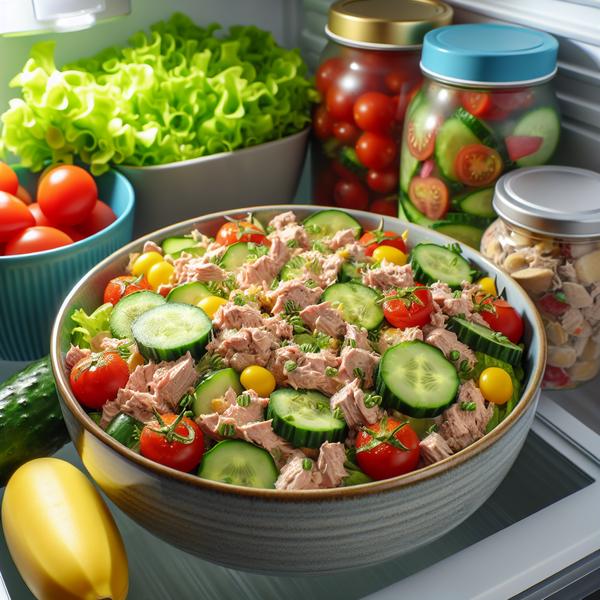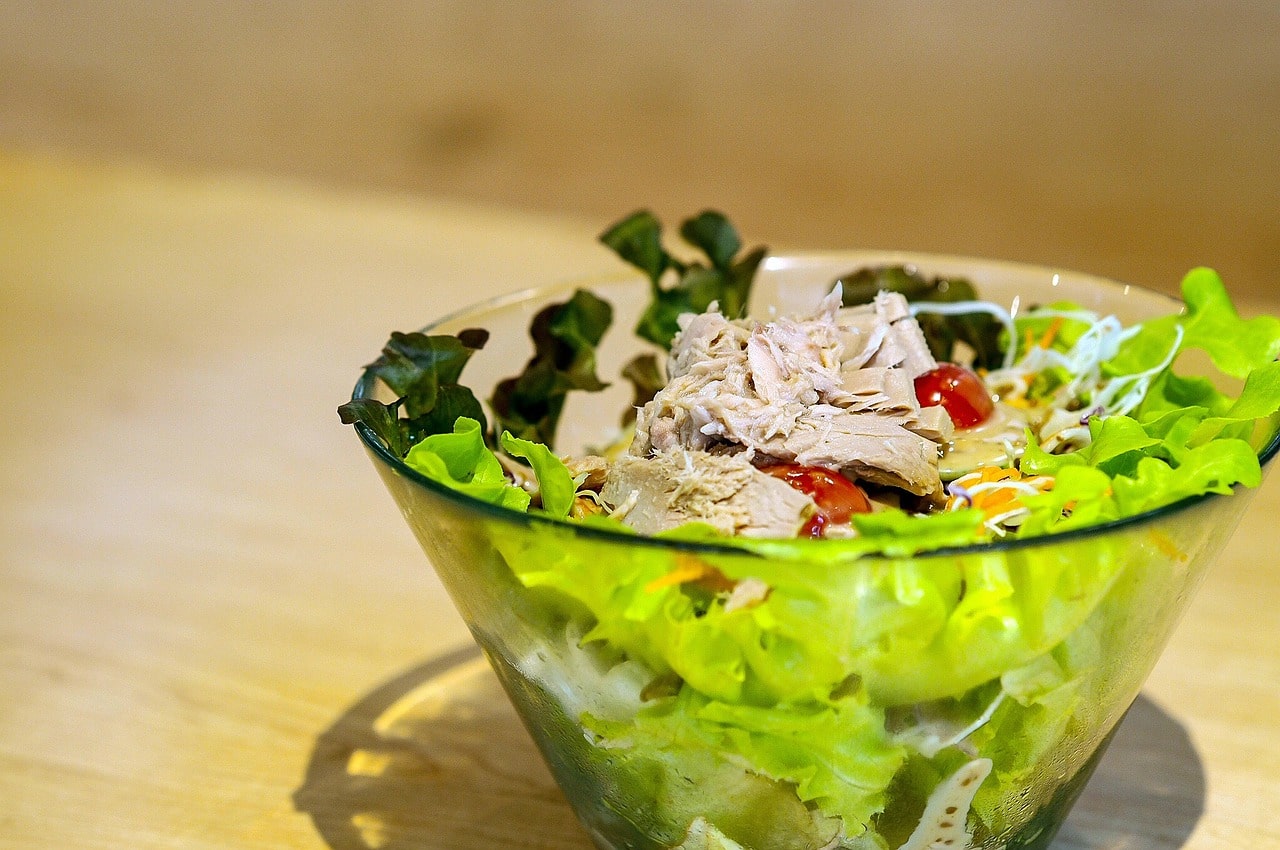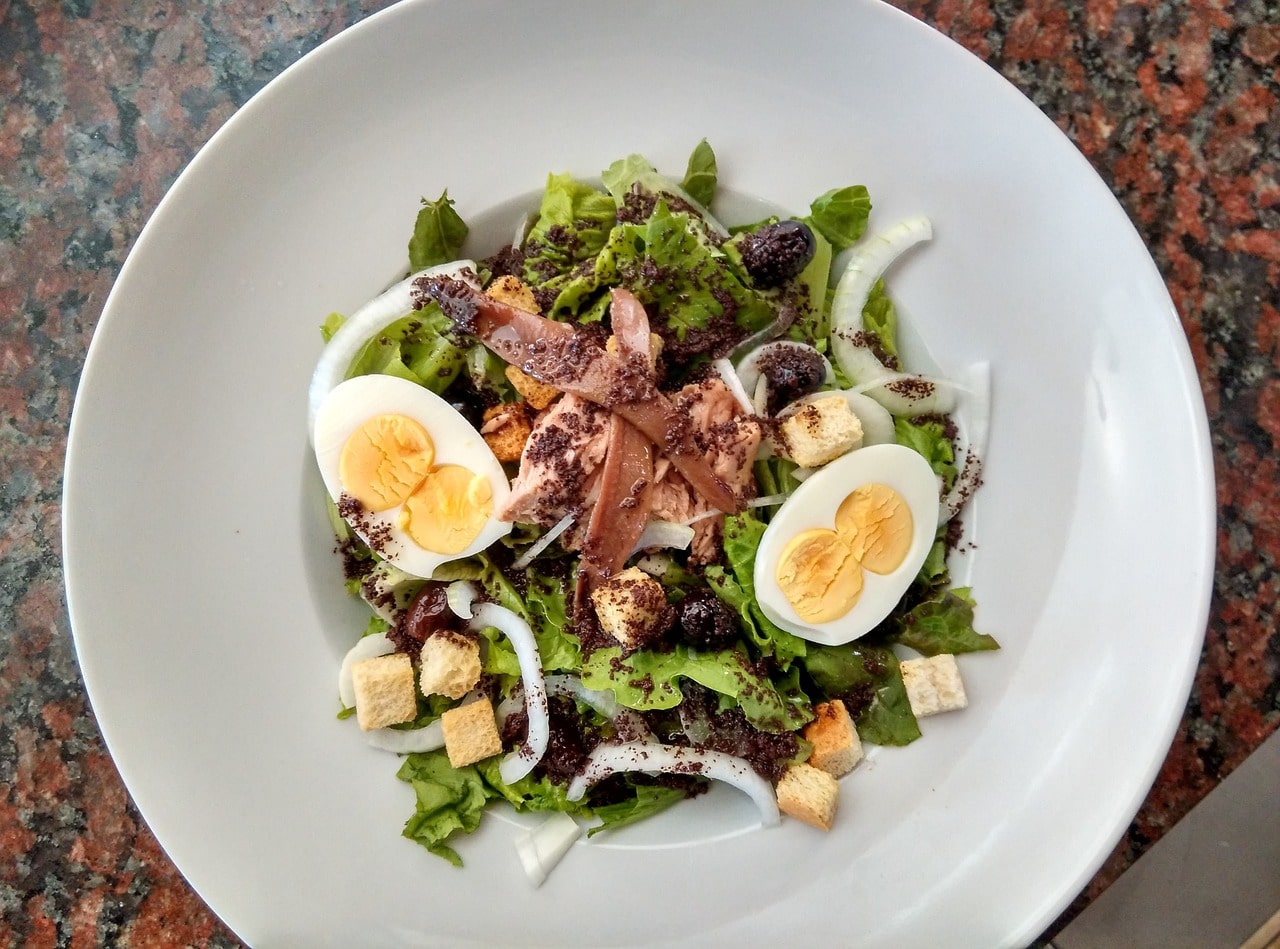How Long Does Tuna Salad Last in the Fridge? (+ Storage Tips)

Does the thought of eating tuna salad that's been in the fridge for too long send shivers down your spine?
Do you lie awake at night worrying about potentially chowing down on something that could land you in the bathroom for days?
Trust me, I hear you. 😱
The fear of food poisoning is real.
But fear not, my friend.
Let's put your concerns to rest and find out once and for all how long that tuna salad can actually last in the fridge.
Ready to dig in?
How Long Does Tuna Salad Last in the Fridge?
The shelf life of tuna salad in the fridge is typically 3 to 5 days, depending on the freshness of the ingredients and proper storage. If unopened, it may last up to 5 days. However, it's recommended to discard any leftovers within 3 to 4 days to ensure food safety.
Here's the deal:
You know that tuna salad you made last night?
Great.
It'll last in your fridge for about 3 to 5 days, give or take.

But let me break it down for you.
A few things come into play here.
First, if you bought your tuna salad from a store, you can check the expiration date on the packaging.
That'll give you an idea of how long it'll stay fresh.
Typically, those unopened packages can last up to 5 days. Not bad, right?
But what if you made your own tuna salad at home?
Well, there's no expiration date printed on your homemade batch.
So you're going to have to use some common sense and follow some guidelines.
For optimal safety, it's best to consume your tuna salad within 3 to 4 days. Even if you don't see any weird colors or funky smells, you should still stick with this time frame. Just to be safe, you know?
Now, let me throw a curveball at you.
What if you whipped up that tuna salad on a Friday to munch on it cozy Saturday night, but it didn't happen?
In that case, I'd suggest saying goodbye to your tuna salad by Tuesday night.
Trust me, it's all about playing it safe when it comes to food.
Now, let me tell you something crucial.
If you want to ensure the lasting freshness and safety of your tuna salad, then you'll definitely want to check out Duration of Jelly's Refrigerator Shelf Life.
How to Tell if Tuna Salad Is Bad?

Here's how you know if your tuna salad is bad:
- If it feels slimy on top, toss it.
- Put any leftover tuna salad in the fridge right away.
- Don't leave it out for more than 2 hours (or just 1 hour if it's hot outside).
- Get rid of any tuna salad that has mold or strange spots - it's no good.
- Be careful not to sniff tuna salad with mold, it can be harmful for your respiratory system.
- Just because it doesn't smell bad, doesn't mean it's fresh. 😷
- Unless there are no other signs of spoilage, don't risk eating spoiled tuna salad.
- Check the expiration date on canned tuna.
- Trust what you see and smell.
- Fresh tuna salad has a gentle scent, but when it's gone off, it stinks.
- Keep an eye out for discoloration, mold, or separated dressing - they're clear signs of spoilage.
- If you have any doubts, throw it away - better to be safe than sorry!
But what if you have leftovers and don't want your tuna salad to go to waste?
Well, here's a solution for you...
Freezing it.
If you've ever wondered whether tuna salad can be frozen, keep reading because I have some tips and tricks that may surprise you.
Yes, it's possible to freeze tuna salad, but there are a few factors to consider.
So, let me walk you through the dos and don'ts of freezing this beloved dish.
Can You Freeze Tuna Salad?
Freezing tuna salad alters its texture, so if you choose this route, omit watery ingredients like celery and onions. Mayo and crunchy components may not hold up well in the freezer.
To ensure even thawing, spread the salad out before freezing.
When it's time to defrost, let it thaw in the fridge.
In essence, freezing tuna salad is feasible but expect changes in texture.
Recommended Cooking Should Be Fun Articles:
- Discover the longevity of opened wine at my article 👉 Duration of Opened Wine
- Can creme fraiche be frozen and how to do it? 👉 Can You Freeze Creme Fraiche
- Explore the safety of refreezing thawed bread here 👉 Refreezing Bread, Is It Safe
Tips for Making Tuna Salad Last Longer
To make your tuna salad last, here's what you need to do:
- When sealing the container, put plastic wrap right on top of the salad. This keeps air and moisture out.
- Keep the salad in an airtight container made of glass or food-safe plastic in the coldest part of your fridge (below 40°F/4°C). Do this within two hours of preparing or eating it.
- Before you eat it, add onion and celery for better taste and longer-lasting freshness. Don't forget to label the container.
- Avoid using containers that absorb liquid and use shelf-stable ingredients for the dressing.
- If you want your salad to stay fresh, skip ingredients like lettuce, tomatoes, hard-boiled eggs, and avocado. 😊
- Always use fresh ingredients and check the expiration dates.
- Don't go overboard with mayo. For a healthier option, add more veggies.
- When making your own dressing, add lemon juice as a natural preservative. Keep it refrigerated below 40°F/4°C.
- The dressing can last up to a week, but throw away any remaining dressing after two weeks.
- Remember, limit your tuna intake to two to three servings per week because of potential mercury.
Note: If you're curious about how long your cooked broccoli can last in the fridge, check out my blog post on How Long Does Cooked Broccoli Last in the Fridge. I advise you to take a look and find out all the details you need to know. Don't worry, I've got you covered!
How to Safely Transport Tuna Salad for Lunch?
Use gel packs and keep it chilled
When you pack tuna salad for lunch, ensure to keep it cool by using gel packs. These packs will help maintain a safe temperature during transit, keeping your salad fresh and delicious.
Don't keep it at room temperature for too long
Now here's a word of caution for you:
Never leave your tuna salad out for more than two hours.
Why?
Because harmful bacteria can grow, which can lead to food poisoning.
Enjoy your salad within those two hours or store it back in the fridge.
Pack it separately and use insulated bags
To avoid any cross-contamination, always pack your tuna salad separately from other food items like bread or crackers.
This ensures that no juice or liquid from the salad comes into contact with other foods, reducing the risk of contamination.
Using insulated lunch bags is highly recommended.
They help maintain the desired temperature, so your tuna salad stays nice and cool until it's time to enjoy.
Once you take the tuna salad out of the fridge, try to eat it soon after.
If, by chance, it has been left at room temperature for more than two hours, it's better to be safe and discard it.
Nobody wants to risk tummy troubles from spoiled tuna salad!
Oh, and one last tip for you:
Make sure to securely tighten the lid of your container to minimize the risk of spills or leaks.
On top of that, when adding dressing, consider pouring it out rather than using utensils for dipping. This helps reduce the chance of contamination.
Maximizing Shelf Life of Tuna Salad
Summary:
- Tuna salad typically lasts between 3-5 days in the fridge.
- Time is a major indicator of spoilage, so eat within 3-4 days.
- Properly sealed, unopened tuna salad can last up to 5 days.
- Discard within 3-5 days even if no visible signs of spoilage.
- Refrigerate promptly and don't leave at room temperature for more than 2 hours.
- Mold, spots, or signs of spoilage indicate the need for disposal.
- Avoid sniffing moldy tuna salad to prevent respiratory issues.
- Absence of smell doesn't guarantee freshness, rely on sight and smell.
- Discoloration, mold, or separated dressing mean it's spoiled.
- Freezing may alter texture, spread out evenly and thaw in fridge.
- Store in airtight container below 40°F within 2 hours.
- Add onion and celery before eating, avoid lettuce and eggs.
- Check expiration dates and limit mayo for longer shelf life.
- Transport safely, avoid leaving at room temperature for over 2 hours.
- Pack separately from bread or crackers to prevent cross-contamination.
And that's all for today folks.
If you want to read more of my useful articles, I recommend you check out some of these: Cooling Down a Curry, Can I Keep a Slow Cooker on for 24 Hours, Duration for Jelly to Solidify, Storing Fresh Yeast Correctly, and How to Store Coffee
Until next time,
-Bianca Rossi